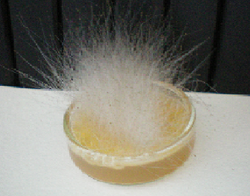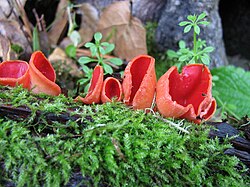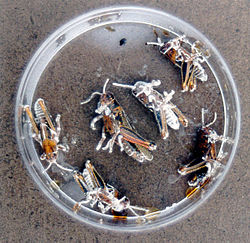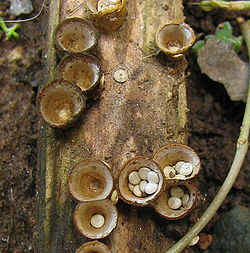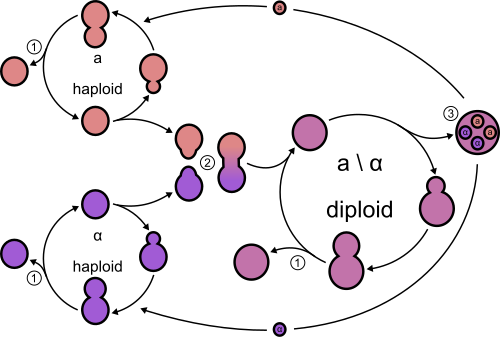Difference between revisions of "AY Honors/Fungi/Answer Key/es"
(Created page with "</noinclude> {{:Adventist Youth Honors Answer Book/Nature/Fungi/Rust infection/es}} <noinclude>") |
(Created page with "</noinclude> Penicillium chrysogenum es un moho que está ampliamente distribuido en la naturaleza y se encuentra usualmente en los alimentos y en los ambientes interiores. Es...") |
||
| Line 83: | Line 83: | ||
{{ansreq|page={{#titleparts:{{PAGENAME}}|2|1}}|num=4b}} | {{ansreq|page={{#titleparts:{{PAGENAME}}|2|1}}|num=4b}} | ||
<noinclude></noinclude> | <noinclude></noinclude> | ||
| − | Penicillium chrysogenum | + | Penicillium chrysogenum es un moho que está ampliamente distribuido en la naturaleza y se encuentra usualmente en los alimentos y en los ambientes interiores. Es la fuente de varios antibióticos β-lactámicos, el más significativo siendo la penicilina. |
Like the many other species of the genus Penicillium, ''P. chrysogenum'' reproduces by forming dry chains of spores (or conidia) from brush-shaped stalks called conidiophores. The conidia are typically carried by air currents to new colonization sites. In ''P. chrysogenum'' the conidia are blue to blue-green, and the mold sometimes exudes a yellow pigment. However, P. chrysogenum cannot be identified based on color alone. Observations of morphology and microscopic features are needed to confirm its identity. | Like the many other species of the genus Penicillium, ''P. chrysogenum'' reproduces by forming dry chains of spores (or conidia) from brush-shaped stalks called conidiophores. The conidia are typically carried by air currents to new colonization sites. In ''P. chrysogenum'' the conidia are blue to blue-green, and the mold sometimes exudes a yellow pigment. However, P. chrysogenum cannot be identified based on color alone. Observations of morphology and microscopic features are needed to confirm its identity. | ||
Revision as of 16:47, 25 February 2021
| Hongos | ||
|---|---|---|
| Asociación General
|
Destreza: 2 Año de introducción: 1937 |
|
Requisitos
|
La especialidad de Hongos es un componente de la Maestría Naturaleza. |
| Conexión Logros para la Investidura: Esta especialidad está relacionada con los requisitos de Logros para la Investidura para GUÍA DE VIDA PRIMITIVA Estudio de la naturaleza que requiere (como una de dos opciones) una actividad que es similar al requisito #2 de esta especialidad. Esta especialidad es una elección popular para la especialidad de la categoría de Estudio de la naturaleza de nivel de destreza 2 o 3 requerido para los GUÍAS DE VIDA PRIMITIVA. |
1
Hay alrededor de 32 clases de hongos, no incluyendo las subdivisiones. Aquí hay unos ejemplos:
- Chytridiomycota
- Los quitridios representan un grupo de hongos acuáticos primitivos. Se caracterizan por tener células reproductivas que se pueden mover a sí mismos mediante el uso de colas en forma de látigo llamadas flagelos. Synchytrium endobioticum es un hongo quítrido que causa la verruga negra de la papa.
Batrachochytrium dendrobatidis, también conocido como Bd o el hongo quítrido de los anfibios, es un hongo quítrido que amenaza la población mundial de anfibios, a los que causa la enfermedad denominada quitridiomicosis. Se trata de un hongo dulceacuícola. Ataca a la piel de los anfibios, la cual es imprescindible para su homeostasis hídrica y gaseosa y defensa inmunológica, dañando la capa de queratina.
- Zygomycota
- Los hongos pertenecientes al filo Zygomycota se caracterizan por formar zygosporas con gruesas paredes, de origen sexual y esporangiosporas no nadadoras, de origen asexual. El moho negro del pan (Rhizopus nigricans) es un representante bien conocido de este grupo del orden Mucorales y produce masas de hifas sobre pan, fruta y otros alimentos deteriorados.
- Glomeromycota
- estos hongos se caracterizan por no presentar una reproducción sexual conocida y ser simbiontes obligados de plantas terrestres. Con éstas forman las endomicorrizas o micorrizas arbusculares, un tipo de asociación micorrizógena que se caracteriza por la entrada de las hifas del hongo en el interior de las células de la raíz de la planta simbionte, donde forman vesículas alimeticias y formaciones conocidas como arbúsculos, que se ramifican dicotómicamente. Se ha observado una sola especie que forma zigosporas; todas las demás especies sólo se reproducen asexualmente.
- Ascomycota
- Los ascomicetos constituyen una división dentro del Reino Fungi. La reproducción puede ser de dos tipos: asexual, por esporas exógenas (conidios o conidioesporas), y sexual, esporas endógenas (ascospora). Han sido aislados de lugares extremos, desde dentro de rocas en la planicie helada de Antártica hasta las profundidades del mar.
- Basidiomycota
- Los basidiomicetos son una división del reino Fungi que incluye los hongos que producen basidios con basidiosporas. Contiene a las clásicas setas y hongos con sombrero.
Todos los hongos carecen de clorofila, las sustancias que permitan que las plantas produzcan su propio alimento mediante la fotosíntesis. En vez, los hongos consiguen comida de plantas en descomposición o materia animal, a través de simbiosis o en el caso de hongos parásitos, de plantas o animales vivos. Aunque a menudo pensamos de las setas como un sinónimo para los hongos, sólo hay alrededor de 10-20.000 especies de setas, de un estimado de 1.500.000 especies de hongos; la mayoría siendo poco visible o microscópica. Sólo alrededor de 80.000 especies de hongos son nombrados.
2
La mejor manera de completar este requisito es ir en busca de hongos y luego tratar de averiguar lo que ha encontrado. Esto es mucho más efectivo que estudiar de su guía de campo, decidir lo que quiere buscar y luego ir en busca.
Asimismo, recuerde que el requisito dice hongos, entonces mantenga los ojos abiertos por los hongos además de las setas. Debe ser fácil de encontrar, fotografíar e identificar los 15 hongos comunes si lleva su cámara siempre que esté en una caminata o de excursión. Los hongos ayudan a descomponer los tocones y troncos, y les gusta la humedad, entonces buscque adecuadamente. Busque también, no sólo hacia abajo, porque algunos hongos crecen en los lados de los árboles. En la cocina y el jardín también puede encontrar el moho negro (¿su madre le permitirá dejar un poco de pan afuera?) y las levaduras.
Para esto, se necesita una guía de campo. La guía de campo que seleccione debe cubrir el área donde está buscando hongos. Por ejemplo, una guía de campo para los hongos de Australia no va a ayudarle mucho si está buscando los hongos en Norteamérica.
Una vez que tenga una guía de campo, tómelo, junto con sucámara o libro de dibujar, y salga en busca de hongos. Cuando encuentre uno, trate de averiguar qué es usando su guía de campo. Es difícil distinguir las diferentes especies de hongos de solamente fotografías, entonces tendrá que identificarlo en el momento. Muchas veces la identificación de una especie se basará en una característica oscura tales como las branquias en la parte inferior de un hongo. Es probable que si se intenta identificar el hongo después de una fotografía, no habrá capturado una de las señas de identidad críticas. Es por eso que va a querer hacer una identificación cuando está en frente del hongo. Si encuentra un espécimen interesante y no tiene su guía de campo, dibújelo y tome fotos. Siempre existe la posibilidad de que será capaz de identificarlo más tarde. Tome nota especial de las branquias (si hay), la forma en que se unen al tallo y cualquier «franjas» alrededor del tallo.
3
Aquí hay cinco hongos de ejemplo utilizados directamente para la alimentación, como un agente para hacer la comida y el alcohol, con fines industriales, para la medicina y como un insecticida biológico en la agricultura.
- Agaricus bisporus
- Esta es una especie de hongo basidiomiceto de la familia Agaricales nativo de Europa y América del norte, cultivado extensamente para su uso en gastronomía. Es la especie de hongo comestible más comúnmente usada para la cocina. Cuando inmaduro y blanco, este hongo puede ser conocido la seta del champiñón. Cuando inmaduro y marrón, este hongo puede ser conocida indistintamente como la seta italiana. Cuando madura, que se conoce como hongos Portobello. A. bisporus se cultiva en más de setenta países y es uno de los hongos más consumidos en el mundo. Cuando la gente piensa de un hongo, esto es por lo general el hongo que viene a la mente es este.
- Saccharomyces cerevisiae (la levadura de cerveza)
- Este hongo se utiliza en la levadura de pan.
- Aspergillus niger
- Este hongo se utiliza para hacer ácido cítrico comercialmente y también puede ser utilizado para hacer ácido glucónico. Ambos son aditivos alimentarios importantes.
- Penicillium chrysogenum
- Este es el organismo que hace la penicilina, a partir del cual se derivan la mayoría de la gran clase de los antibióticos beta-lactámicos. La penicilina y sus derivados han salvado innumerables vidas desde que fueron descubiertos y aislados, a partir de la década de 1940.
- Beauveria bassiana
- Este hongo ascomiceto mitospórico que crece de forma natural en los suelos de todo el mundo. Su poder entomopatógeno le hace capaz de parasitar a insectos de diferentes especies, causando la conocida enfermedad blanca de la muscardina. Pertenece a los hongos entomopatógenos y actualmente es utilizado como insecticida biológico o biopesticida controlando un gran número de parásitos de las plantas como son las orugas, las termitas, las moscas blancas, los áfidos, los escarabajos o los tisanópteros.
4
4a
4b
Penicillium chrysogenum es un moho que está ampliamente distribuido en la naturaleza y se encuentra usualmente en los alimentos y en los ambientes interiores. Es la fuente de varios antibióticos β-lactámicos, el más significativo siendo la penicilina.
Like the many other species of the genus Penicillium, P. chrysogenum reproduces by forming dry chains of spores (or conidia) from brush-shaped stalks called conidiophores. The conidia are typically carried by air currents to new colonization sites. In P. chrysogenum the conidia are blue to blue-green, and the mold sometimes exudes a yellow pigment. However, P. chrysogenum cannot be identified based on color alone. Observations of morphology and microscopic features are needed to confirm its identity.
4c
Bird's nest fungi are fungi with fruiting bodies that look like egg-filled birds' nests and make up the order the Nidulariales.
They are often seen on decaying wood and in soils enriched with wood chips or bark mulch. Cyathus striatus is probably the most commonly encountered species in the temperate northern hemisphere.
The "eggs" are spore cases called peridioles. Peridioles contain glebal tissue, basidia (a microscopic, spore-producing structure), and basidiospores (a reproductive spore), and are dispersed by rain. The nests are splash cups. When a raindrop hits one at the right angle the walls are shaped such that the eggs are expelled a good distance from the nest. Each egg has a sticky trailing thread attached to it. If that thread encounters a twig on its flight the egg will swing around and wrap itself around the twig. The spores can then germinate there and start the life cycle over again.
4d
Yeasts have asexual and sexual reproductive cycles; however the most common mode of vegetative growth in yeast is asexual reproduction by budding or fission. Here a small bud, or daughter cell, is formed on the parent cell. The nucleus of the parent cell splits into a daughter nucleus and migrates into the daughter cell. The bud continues to grow until it separates from the parent cell, forming a new cell. The bud can develop on different parts of the parent cell depending on the genus of the yeast.
Under high stress conditions haploid cells will generally die, however under the same conditions diploid cells (cells containing a full set of chromosomes) can undergo sporulation, entering sexual reproduction (meiosis) and producing a variety of haploid spores (which have only a half-set of chromosomes), which can go on to mate (conjugate), reforming the diploid.
5
Fusarium oxysporum
Adventist Youth Honors Answer Book/Nature/Fungi/Fusarium oxysporum
Downy mildew
Adventist Youth Honors Answer Book/Nature/Fungi/Downy mildew
Botrytis (Leaf blight, Neck rot)
Adventist Youth Honors Answer Book/Nature/Fungi/Botryotinia
Alternaria alternata
Adventist Youth Honors Answer Book/Nature/Fungi/Alternaria alternata
Smut
Adventist Youth Honors Answer Book/Nature/Fungi/Smut
Magnaporthe grisea
Adventist Youth Honors Answer Book/Nature/Fungi/Magnaporthe grisea
6
Mushrooms
Harvesting wild mushrooms is an age-old practice and remains an important economic activity around the world. However, there are poisonous mushrooms that look much like edible mushrooms. Be sure to have your pick checked by an experienced mushroom expert or buyer before consuming anything you pick. Better yet, don't pick and eat wild mushrooms at all (unless you are a trained professional).
According to the excellent book The North America Guide to Common Posionous Plants and Mushrooms, there are about 100 known poisonous species out of about 5000 named species of mushrooms in the United States. One third to one half of mushroom taxa in the USA remain unidentified and many of the identifed species are not gathered for food and have not been tested for toxicity. The situation in other parts of the world is even worse, where there is often a very limited understanding and no local guides to what mushrooms grow there. Relying on a North American or European guidebook in another region could prove deadly since toxicity levels between similar looking mushrooms vary around the world.
Also be aware that mushrooms can be introduced to new regions, often unwittingly brought in soil with nursery stock.
If you suspect mushroom poisoning (which may manifest hours after consuming mushrooms), seek immediate medical attention. Bring a sample of the mushroom to the hospital and call a poison control center. Globally, over 50% of mushroom poisonings are fatal, but with good medical care and prompt attention over 90% of victims recover in North America.
Mold
Flood conditions contribute to the growth and transmission of many kinds of fungi, some of which can cause sickness. Cleanup workers are at increased risk of exposure to airborne fungi and their spores because they often handle moldy building materials, decaying vegetable matter, rotting waste material, and other fungus-contaminated debris. The fungal material is carried into the respiratory tract when airborne particles are inhaled.
There are many different kinds of fungi, including mildew, molds, rusts, and yeasts. Most of these are harmless, but some can cause respiratory and other disorders when workers inhale or come into contact with fungi. Inhalation is the route of exposure of most concern to flood cleanup workers. The recommendations below offer strategies for workers renovating flooded buildings, homes, and structures to protect themselves while handling building materials that are visibly contaminated with fungi.
For workers cleaning up flooded buildings, homes, and other structures, excessive moisture or water accumulation indoors will encourage the growth of the fungi that are already present. Some fungi have the potential to cause adverse health effects such as allergic responses and asthma attacks. Individuals who are sensitive to molds may have signs and symptoms of allergic reactions such as nasal stuffiness, eye irritation, and wheezing. These individuals should minimize fungal exposure by wearing respirators, gloves, and eye protection. They should also seek to eliminate fungi, as described below. In addition, repeated or prolonged contact of the skin with flood water and continuous sweating can lead to fungal skin infections. These can be minimized or avoided by washing the skin with warm, soapy water and keeping it as dry as possible.
If a person experiences severe allergic or skin symptoms, or severe flu-like symptoms, he or she should seek medical advice. A health care provider can determine whether medication or any other precautions are necessary.
Tips to Remember
For anyone who may be exposed to mold and fungi:
- Avoid breathing dust (fungal spores) generated by moldy building materials, crops, and other materials.
- Consider using a disposable respirator as a minimum when working with moldy or damp hay, grain, compost, or building materials.
- Consider discarding all water damaged materials. Articles that are visibly contaminated with mold should be discarded. When in doubt, throw it out.
- Surfaces that have a light covering of mold should be scrubbed with warm, soapy water and rinsed with a disinfectant made of 1/2 cup liquid household bleach mixed into one gallon of water.
- CAUTION: Do not mix bleach with other cleaning products that contain ammonia.
- After working with mold-contaminated materials, wash thoroughly, including the hair, scalp, and nails.
- If the safety of food or beverage is questionable, throw it out. Only drink safe drinking water that has been bottled, boiled, or treated until there is confirmation that the community water supply is safe for consumption.
For additional information concerning fungi, health effects, and addressing flood damaged materials, please visit OSHA’s Safety and Health Topics web page on Molds and Fungi at: http://www.osha.gov/SLTC/molds/index.html
References
- http://www.caes.state.ct.us/PlantPestHandbookFiles/pphO/pphonio.htm
- http://www.osha.gov/OshDoc/data_Hurricane_Facts/Bulletin3.pdf
- Boundless. “Importance of Fungi in Human Life.” Boundless Biology. Boundless, 21 Jul. 2015. Retrieved 30 Sep. 2015 from https://www.boundless.com/biology/textbooks/boundless-biology-textbook/fungi-24/importance-of-fungi-in-human-life-153/importance-of-fungi-in-human-life-601-12945/
- Categoría: Tiene imagen de insignia
- Adventist Youth Honors Answer Book/Honors/es
- Adventist Youth Honors Answer Book/es
- Adventist Youth Honors Answer Book/Skill Level 2/es
- Categoría: Libro de respuestas de especialidades JA/Especialidades introducidas en 1937
- Adventist Youth Honors Answer Book/General Conference/es
- Adventist Youth Honors Answer Book/Nature/es
- Adventist Youth Honors Answer Book/Nature/Primary/es
- Adventist Youth Honors Answer Book/Stage 75/es
- Adventist Youth Honors Answer Book/Naturalist Master Award/Flora/es
- Adventist Youth Honors Answer Book/IAConnection/es
- Adventist Youth Honors Answer Book
- Adventist Youth Honors Answer Book/Do at home


